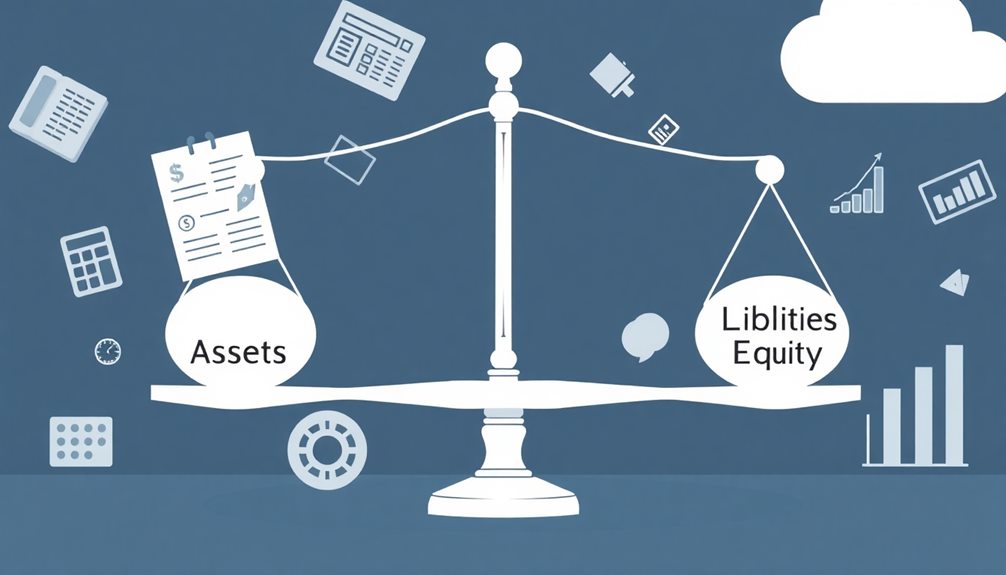The accounting equation, Assets = Liabilities + Equity, is fundamental for understanding your company's financial health. It shows how your assets are financed, either through debt (liabilities) or owner investments (equity). Assets include current items like cash and accounts receivable, as well as non-current items like property. Liabilities are split into current and long-term obligations. Equity represents the net worth after all debts are settled. This equation also underpins double-entry bookkeeping, ensuring each transaction balances. Discovering more about this equation can enhance your ability to assess financial statements and make informed decisions.
Key Takeaways
- The accounting equation, Assets = Liabilities + Equity, reflects the relationship between a company's resources and its financial obligations.
- Assets are divided into current and non-current categories, impacting liquidity and long-term financial health.
- Liabilities are classified as current or long-term, affecting repayment schedules and overall risk assessment.
- Equity represents the owners' residual interest in the company, crucial for evaluating financial stability and growth potential.
- Understanding this equation is essential for accurate financial reporting and informed decision-making by stakeholders.
Overview of the Accounting Equation

The accounting equation is at the heart of financial accounting, expressing the relationship between a company's assets, liabilities, and equity. This equation, represented as Assets = Liabilities + Equity, is essential for maintaining a balanced balance sheet. It highlights how a company's total assets are financed through liabilities and equity, ensuring you understand where your resources come from and how they're claimed.
In double-entry bookkeeping, every business transaction affects at least two accounts, keeping the accounting equation intact. For example, if you purchase equipment (an asset) using a loan (a liability), both sides of the equation adjust, maintaining balance.
This integrity is important for accurate financial reporting, allowing stakeholders to assess your company's financial health and ability to meet obligations.
Equity, often referred to as shareholders' equity for corporations or owners' equity for sole proprietorships, reflects the legal structure of your business while adhering to the accounting equation. By grasping this foundational concept, you gain insight into your total assets and understand the sources of funding that drive your operations.
Key Components of the Equation

Understanding the key components of the accounting equation is essential for grasping how your company's finances are structured. The equation itself—Assets = Liabilities + Equity—highlights three significant elements.
First, assets are the valuable resources your company controls. These include current assets like cash and accounts receivable, which can be quickly converted to cash, and non-current assets such as property and machinery, which serve your business long-term.
Liabilities represent your financial obligations to external parties. They're divided into current liabilities, due within one year, and long-term liabilities, which extend beyond that. Managing these obligations is important for maintaining your business's liquidity and creditworthiness.
Finally, shareholders' equity reflects the net worth of your company available to owners after settling all debts. This includes common stock, which represents ownership shares, and retained earnings, which are profits reinvested in the business.
Each of these components plays a critical role in providing a complete picture of your company's financial health, influencing decisions made by investors, creditors, and management.
Understanding them will empower you to make informed financial decisions.
Real-World Applications

When you look at real-world applications of the accounting equation, you'll see how it plays an essential role in practical business scenarios.
For example, analyzing financial statements helps you gauge a company's health and make informed decisions.
Understanding this equation can also guide you in evaluating risk when considering loans or investments.
Practical Business Examples
While analyzing real-world applications of the accounting equation, you'll find that many successful companies exemplify this fundamental principle. Here are some practical examples that illustrate how the accounting equation holds true across various contexts:
- Apple Inc.: As of September 2023, Apple reported total assets of $351 billion, with liabilities of $123 billion and shareholders' equity of $228 billion, confirming the equation: $351 billion = $123 billion + $228 billion.
- Microsoft: In June 2023, Microsoft's financial statements showed assets of $365 billion, liabilities of $183 billion, and equity of $182 billion, reinforcing the accounting equation.
- Small Bakery: A local bakery with total assets of $50,000, liabilities of $20,000, and shareholders' equity of $30,000 exemplifies the equation as well: $50,000 = $20,000 + $30,000.
- Retail Company: A retail company maintains a balance of $200,000 in assets, $75,000 in liabilities, and $125,000 in equity, effectively illustrating the equation: $200,000 = $75,000 + $125,000.
These examples highlight how the accounting equation is an essential tool in understanding a business's financial health through its balance sheet and financial statements.
Financial Statement Analysis
How can financial statement analysis enhance your understanding of a company's performance? By applying the accounting equation (Assets = Liabilities + Equity), you can assess a company's financial health through its balance sheet.
This analysis allows you to identify discrepancies and evaluate the relationship between total assets, total liabilities, and total equity.
When you explore financial statement analysis, key ratios like the debt-to-equity ratio become essential. This ratio reveals insights into a company's financial leverage and risk profile, helping you gauge whether a company is taking on too much debt compared to its equity.
For instance, examining Exxon Mobil Corp.'s balance sheet as of March 31, 2024, shows total assets of $377,918 million, total liabilities of $164,866 million, and total equity of $213,052 million, confirming the accounting equation's validity.
Understanding Assets and Liabilities

When you look at a company's financial health, understanding assets and liabilities is key.
You'll find that assets are split into current and non-current types, while liabilities are categorized as current or long-term.
Recognizing these classifications helps you manage your finances more effectively and maintain a balanced accounting equation.
Asset Classification Types
Assets are frequently categorized into two main types: current assets and non-current assets. Understanding these classifications is vital for analyzing a company's financial health and liquidity, especially in relation to liabilities and equity.
Here's a breakdown of the two categories:
- Current Assets: These can be converted into cash within one year. They typically include:
- Cash
- Accounts Receivable
- Short-term Investments
- Inventory
- Non-Current Assets: Held for longer than a year, these include:
- Property and Equipment
- Machinery
- Intangible Assets (like patents)
- Long-term Investments
The classification of assets directly impacts how you evaluate current liabilities and long-term liabilities. It's essential for financial reporting and calculating the accounting equation (Assets = Liabilities + Equity).
Liability Management Strategies
What strategies can you implement to manage your company's liabilities effectively? Start by categorizing your liabilities into current and long-term. This helps you assess repayment timelines better and maintain financial stability. Create a liability schedule to track due dates and amounts, ensuring timely payments that avoid late fees.
Monitoring your debt-to-equity ratio is essential. A higher ratio can signal excessive leverage, increasing your financial risk. Optimize cash flow by negotiating favorable payment terms with suppliers, providing you with more flexibility in managing current liabilities.
Regularly reviewing your liabilities can uncover opportunities for refinancing or consolidating debts, which can help reduce interest costs and improve cash management. Here's a quick overview of effective liability management strategies:
| Strategy | Benefit |
|---|---|
| Categorize liabilities | Better assessment of payments |
| Monitor debt-to-equity ratio | Reduce financial risk |
| Negotiate payment terms | Improve cash flow management |
Importance of the Double-Entry System

The double-entry system is fundamental for maintaining the integrity of financial reporting and guaranteeing accuracy across all transactions. This accounting method requires that every transaction impacts at least two accounts, keeping the accounting equation (Assets = Liabilities + Equity) in balance.
Here are some key reasons why this system is essential:
- Accuracy: Each debit must have a corresponding credit entry of equal value, greatly reducing errors in financial reporting.
- Discrepancy Identification: The balanced equation allows you to easily spot discrepancies, helping you address financial issues promptly.
- Reliable Financial Statements: Originating in the 14th century, this system has become the global standard for accounting, enhancing the reliability of financial statements.
- Informed Decision-Making: The double-entry system generates thorough financial reports that provide insights into a company's financial position, performance, and cash flow.
For stakeholders, understanding these aspects is critical in evaluating a business's health.
Calculating Shareholders' Equity

Calculating shareholders' equity is crucial for understanding a company's financial health. You can determine this by using the formula: Equity = Assets – Liabilities. This equation represents the net worth of a company after settling all its debts, giving you a clear picture of its financial stability.
Shareholders' equity includes several key components like common stock, preferred stock, retained earnings, and additional paid-in capital. Retained earnings, in particular, play a considerable role; they represent accumulated profits reinvested in the business rather than paid out as dividends.
While the book value of shareholders' equity provides a baseline for evaluation, it's important to realize that the market value can differ notably. Factors like asset appreciation, prevailing market conditions, and investor sentiment can impact this discrepancy.
Understanding shareholders' equity is crucial for your investment decision-making process. It not only reflects the ownership interest in the company but also serves as a critical indicator of potential growth and overall financial health.
Frequently Asked Questions
How to Understand an Accounting Equation?
To understand an accounting equation, you need to identify the components involved. Break down each element, such as assets, liabilities, and equity, to see how they interact and reflect a company's financial situation.
What Is the Relation of Assets Liabilities and Equity Reflected in the Equation?
Isn't it fascinating how your company's financial health hinges on the balance between assets, liabilities, and equity? Each component reflects your resources, debts, and ownership stake, creating a holistic view of your financial position.
What Is the Assets Formula in Accounting Equation?
In accounting, the assets formula shows how resources are balanced with claims against them. You'll see that total assets equal the sum of what you owe and your ownership stake in the business.
What Is the Balance Sheet Explained?
Did you know that nearly 75% of investors rely on balance sheets to gauge company performance? A balance sheet summarizes your financial position, revealing assets, liabilities, and equity, helping you assess overall financial health efficiently.
Conclusion
In understanding the accounting equation, you see it's not just numbers; it's a clear reflection of your business's financial health. You might think it's too complex to grasp, but once you break it down into assets, liabilities, and equity, it all clicks. By mastering this equation, you're better equipped to make informed decisions, ensuring your business thrives. So, embrace the accounting equation—it's your roadmap to financial success!










